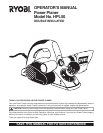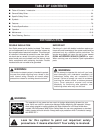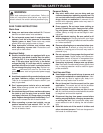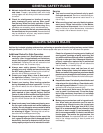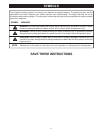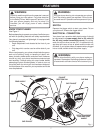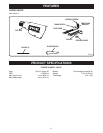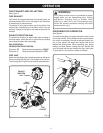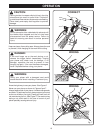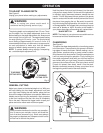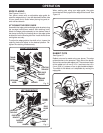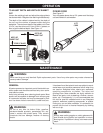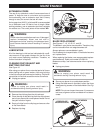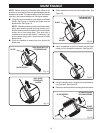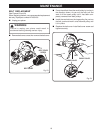
4
GENERAL SAFETY RULES
Service
■ Tool service must be performed only by quali-
fied repair personnel. Service or maintenance per-
formed by unqualified personnel could result in a
risk of injury.
■ When servicing a tool, use only identical replace-
ment parts. Follow instructions in the Mainte-
nance section of this manual. Use of unauthorized
parts or failure to follow Maintenance Instructions
may create a risk of electric shock or injury.
SPECIFIC SAFETY RULES
Hold tool by insulated gripping surfaces when performing an operation where the cutting tool may contact hidden
wiring or its cord. Contact with a “live” wire will make exposed metal parts of the tool “live” and shock the operator.
Check for alignment of moving parts, binding of
moving parts, breakage of parts, mounting, and
any other conditions that may affect its operation.
A guard or other part that is damaged should be
properly repaired or replaced by an authorized
service center. Following this rule will reduce the
risk of shock, fire, or serious injury.
■ Keep handles dry, clean, and free from oil, and
grease. Always use a clean cloth when cleaning.
Never use brake fluids, gasoline, petroleum-based
products or any strong solvents to clean your tool.
Following this rule will reduce the risk of serious per-
sonal injury.
■ Keep blades clean. Periodically check blades and
chip exhaust for chip build-up. Clean blades mini-
mize stalling and kickback. Following this rule will
reduce the risk of serious personal injury.
■ Do not abuse cord. Never carry the tool by the
cord or yank it to disconnect it from the recep-
tacle. Keep cord away from heat, oil, and sharp
edges. Following this rule will reduce the risk of elec-
tric shock or fire.
■ Make sure your extension cord is in good condi-
tion. When using an extension cord, be sure to
use one heavy enough to carry the current your
product will draw. A wire gage size (A.W.G.) of at
least 16 is recommended for an extension cord
100 feet or less in length. A cord exceeding 100
feet is not recommended. If in doubt, use the next
heavier gage. The smaller the gage number, the
heavier the cord. An undersized cord will cause a
drop in line voltage resulting in loss of power and
overheating.
Additional Rules For Safe Operation
■ Know your power tool. Read operator’s manual
carefully. Learn its applications and limitations,
as well as the specific potential hazards related
to this tool. Following this rule will reduce the risk
of electric shock, fire, or serious injury.
■ Always wear safety glasses. Everyday eye-
glasses have only impact-resistant lenses; they
are NOT safety glasses. Following this rule will re-
duce the risk of serious personal injury.
■ Protect your lungs. Wear a face or dust mask if
the operation is dusty. Following this rule will re-
duce the risk of serious personal injury.
■ Protect your hearing. Wear hearing protection
during extended periods of operation. Following
this rule will reduce the risk of serious personal in-
jury.
■ Inspect tool cords periodically and, if damaged,
have repaired at your nearest Factory Service
Center or other Authorized Service Organization.
Constantly stay aware of cord location. Follow-
ing this rule will reduce the risk of electric shock or
fire.
■ Keep hands away from blades and planing area.
Do not reach underneath work while blades are
rotating. Do not attempt to remove material while
blades are rotating. Blades continue to rotate af-
ter releasing of trigger. Following this rule will re-
duce the risk of serious personal injury.
■ Check damaged parts. Before further use of the
tool, a guard or other part that is damaged should
be carefully checked to determine that it will op-
erate properly and perform its intended function.
■ Maintain tools with care. Keep cutting tools sharp
and clean. Properly maintained tools with sharp
cutting edges are less likely to bind and are easier
to control.
■ Check for misalignment or binding of moving
parts, breakage of parts, and any other condi-
tion that may affect the tool’s operation. If dam-
aged, have the tool serviced before using. Many
accidents are caused by poorly maintained tools.
■ Use only accessories that are recommended by
the manufacturer for your model. Accessories that
may be suitable for one tool, may become hazard-
ous when used on another tool.



